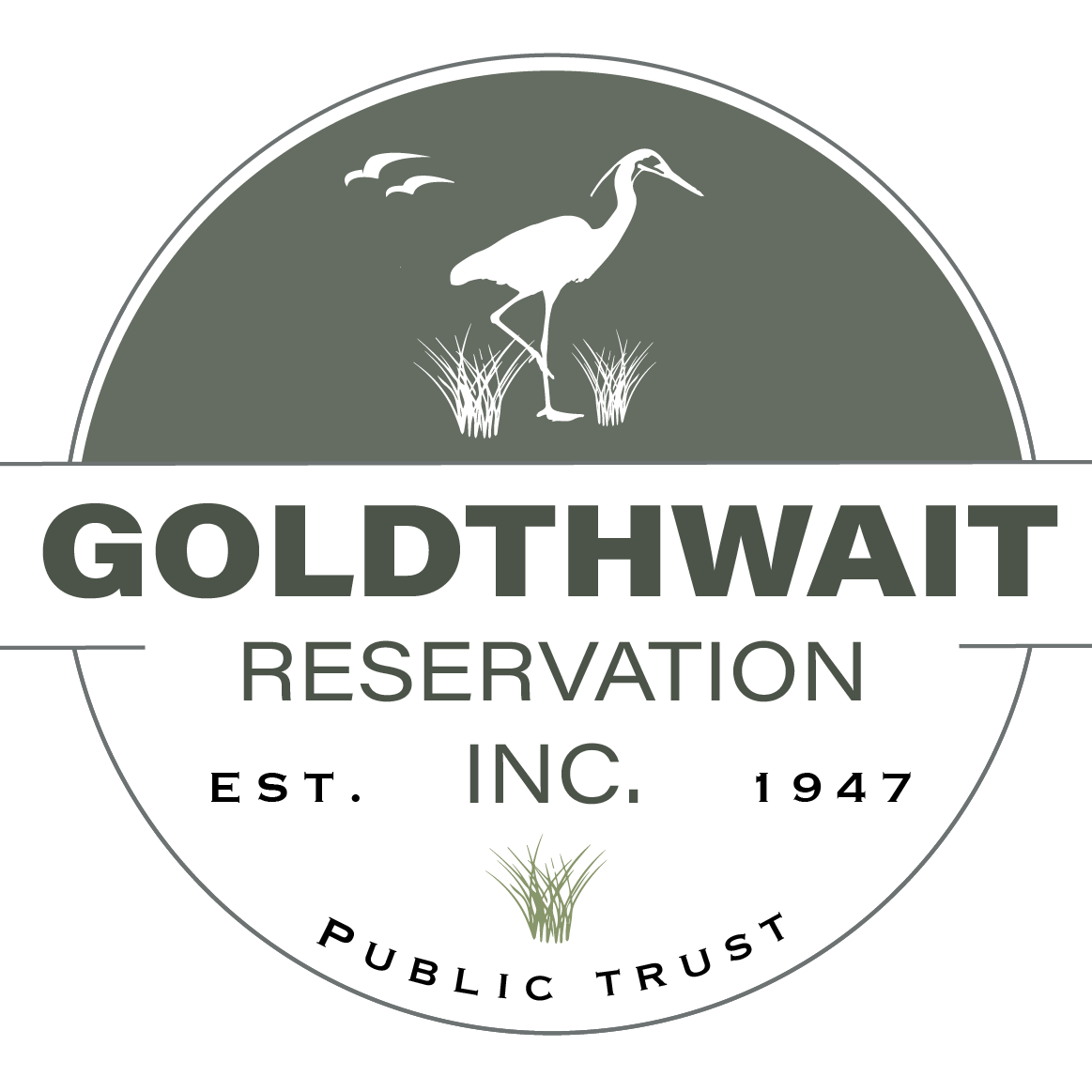EXPLORE THE ECOSYSTEMS OF GOLDTHWAIT
SALT MARSH
The Goldthwait Reservation contains a large area of salt marsh and a fringe of freshwater marsh around much of the perimeter. The Goldthwait salt marsh is connected to the Riverhead Beach area by a large diameter culvert which passes under Ocean Avenue. This culvert functions very much like a tidal creek, allowing water to flow into and out of the marsh with the tide. The dominant salt-tolerant plants within the salt marsh are Salt Meadow Cord Grass (Spartina patens) and Salt Marsh Cord Grass (Spartina alterniflora). The salt marsh also contains tidal creeks, ditches, and small pools.
The tidal and fresh water inputs and the salt marsh vegetation play an important role in providing critical habitat for fisheries, shellfisheries, and wildlife. Fish passage into the marsh appears unrestricted during the higher stages of the tide. The resident fish are those that are tolerant of varying fluctuations to tidal flow and freshwater runoff, and to its conditions, such as salinity, temperature, and dissolved oxygen. The principal residents of the marsh are Mummichog and Sticklebacks. These species spawn and feed within the marsh and may reside here year-round. These fish enter the upper reaches of the small tidal creeks to feed at high tide and descend into the main channels as the tide recedes. Several other fish species, particularly Atlantic Silversides, enter the marsh to feed at high tide, but exit as the tide recedes.
Salt marshes are considered one of the most productive of all environments because they serve a number of vital functions, including a major role in the complex coastal marine food web. The marsh is an important source of nutrients which form the basis of the coastal food web. The ebb and flow of the tide flushes nutrients (in the form of detritus) from the marsh into the coastal waters, thus contributing to the productivity of the coastal regions. For the marsh to continue its role in the food web, a free connection between the marsh and Riverhead Beach must be maintained.
In addition to the ecological benefits, the Goldthwait salt marsh plays many other important roles, such as helping to prevent storm damage, control flooding, protect the groundwater supply, and prevent pollution. The Goldthwait salt marsh vegetation acts as a protective barrier against storm damage and flooding by slowing, reducing, and absorbing flood waters before they reach upland areas. In addition, the salt marsh vegetation can help trap sediments and build the height of the marsh to further protect inland areas from sea level rise and storm waves. The vegetation can also help trap and store excess nutrients and filter pollutants before they reach the groundwater supply or coastal waters.
Because of the vital functions that salt marshes play, they are heavily regulated under the Massachusetts Wetland Protection Act and Regulations—proposed projects in a salt marsh, or even on lands within 100 feet of a salt marsh, shall not destroy any portion of the salt marsh and shall not have an adverse effect on its productivity.
COBBLE DUNE AND BEACH
The Golthwait Reservation is endowed with a beautiful cobble dune and beach, which transitions to sandy tidal flats at low tide. A boardwalk provides access over the cobbles to reach an area perfect for many types of recreation, such as swimming, picnicking, fishing, paddle-boarding, and sunbathing.
An important benefit of a cobble dune system is its resistance to storms, especially since this dune is part of a barrier beach system (i.e., a narrow low-lying spit of land consisting of coastal beaches and dunes that front a salt marsh or other waterbody). The dune’s height and width provide a buffer that protects landward areas from storm waves, storm surges, and extreme high tides. The cobbles are also less prone to both short and long-term erosion than sandy sediments. The overwash of cobbles on the back side of the dune during storm events is a process of natural landward migration of sediments. If dunes are prevented from migrating landward (or cobbles are moved back to the top and face of the dune), they will gradually be eroded away from the seaward side and diminish in size. With rising sea levels, this landward migration will allow the dune to maintain its form and volume over time and continue to be an effective protective barrier.
THE PARK AREA
Goldthwait Reservation also maintains a beautiful park area—a grassy open space with a fire pit, stone seating, native coastal plants, and a perfect setting to hold events and gatherings. Over the past years, attempts have been made to increase the number of coastal native plants, such as beach plum, serviceberry, and highbush blueberry. Non-natives, such as rugosa rose, are still maintained here, but are kept in check. The area is maintained with minimal to no use of fertilizers that have the potential to increase excess nutrients to the salt marsh, as well as little use of irrigation water for the grass. The intent is to keep the park area in a natural coastal landscape condition, while allowing for comfortable access and gatherings. See Policies and Permits for information about holding an event at Goldthwait Reservation.
RIVERHEAD BEACH AND TIDAL FLATS
Though not officially part of the Goldthwait Reservation, the marsh is tidally flushed through the Riverhead Beach area and is therefore considered an integral part of the beach system. Riverhead beach consists primarily of a large area of tidal flats, a portion of rocky intertidal shore, mussel beds, and a small bed of eelgrass. Though the Massachusetts Division of Marine Fisheries has not mapped the Riverhead Beach area as a productive shellfish habitat, large number of Blue Mussel (Mytilus edulis) and small numbers of the Soft Shell Clam (Mya arenaria) are found there. The tidal flats could possibly be considered a productive shellfish area in the future, though it is unlikely that harvesting would be allowed. The bird species that frequent the area are also quite diverse.

